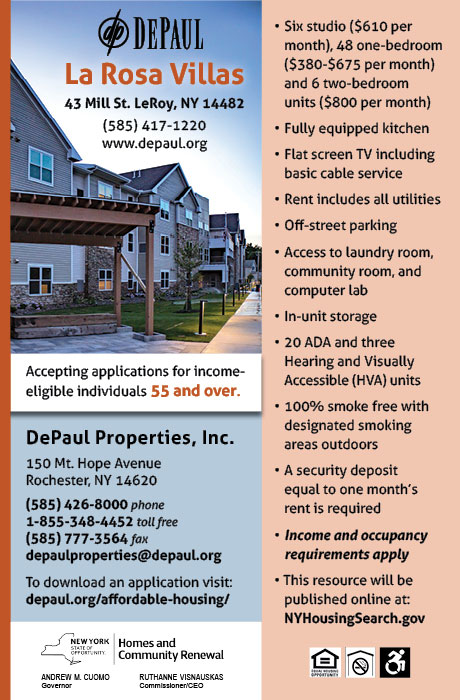housing
City response to state housing proposal: 'land in the city is limited,' each project should be carefully planned
Just prior to a vote by City Council last month to approve Gov. Kathy Hochul’s Housing Compact, some council members asked to put on the brakes before giving the state carte blanche with such a mandate.
The original resolution gave the state control over local housing plans, which included requiring New York municipalities to increase their housing stock by 1 percent annually. A few paragraphs of the state’s resolution were redrafted, and council is expected to vote on the tweaked version during Monday’s business meeting. Those revisions now urge the state Legislature to reevaluate Hochul’s compact proposal and the potential impacts it would have on municipalities, especially in upstate communities, including Batavia.
The business meeting is set for 7 p.m. in the Council Board Room at City Hall.
Hochul has included the housing compact as part of her 2024 budget proposal, with a goal to build 800,000 housing units across New York State over the next decade. If approved, this measure would require cities, towns and villages in the state to achieve certain thresholds over three-year periods and require upstate municipalities to increase housing stock by 1 percent annually.
Batavia may be stripped of any local zoning, planning or land-use regulations powers if housing targets are not met and allow mixed-income multi-family projects to take advantage of a fast-track housing approval process, city leaders say.

Some of the focus of these documents includes more market-rate housing downtown, single-family homes in neighborhoods, condos for workforce renters and owners, and market-rate apartments throughout the city. There isn't enough market-rate housing for seniors and millennials in Batavia. There's a shortage of rentals Downtown.
The report from CZB consultants in 2008 showed there was no demand for additional affordable housing, contrary to what the city now has coming with Ellicott Station. Instead, there was a need for 187 homes in the $50,000 a year income range, which is now estimated, due to inflation, to be closer to $75,000 or higher, Tabelski said.
During that Feb. 27 meeting, Councilman Bob Bialkowski asked to change a couple of the governor’s proposed paragraphs because “some of this could be taken out of context,” he said.
“And the other thing is, the city of Batavia will continue to make significant investments in housing development … how much of an investment are we going to make? Over what period of time? Do we even have land to build more housing?”
Council members Rich Richmond and President Eugene Jankowski Jr. agreed, which prompted the resolution going back for revisions before a final vote.
“New home building and construction should not take priority over the well-being of residents and a community, which is what could be at stake if the new State Housing Approval Board is given overriding authority to local regulations, is part of the resolution for Monday’s vote.”
To answer Bialkowski’s question about land for housing, several areas have been identified, Tabelski said. Those are located on:
- Burke Drive
- Creek Park
- Swan Street / Harvester Avenue
- Former Armory site
- North Street/ Naramore Neighborhood
- Days Inn / Super 8 site
- Former Batavia Iron and Metal site
- Bank Steet/Alva Avenue
- JC Penney site / City Centre
- Harvester Center
- Flood plain properties
- Various zombie, abandoned houses
- Upper-floor residential opportunities
The STAMP site on the county’s west side has a need for owner-occupied units for moderate to high-income occupants, she said -- 382 new owner-occupied and 735 new rentals, with high-end growth needs of 941 new owner-occupied and 2,035 new rental needs.
So the governor is not off base with a projection for housing needs. It’s just that city leaders would like to maintain more control over how and where it happens and that it meets the consultants’ recommendations, such as the unmet demand for market-rate versus low-income housing units.
“Past studies have shown that there are different types of housing needs in the City Of Batavia — from downtown apartments to single-family homes. However, land within the city is limited, so I think it’s important that each project be carefully planned,” Jankowski said. “My bigger concern is that the Governor’s Housing Compact legislation has the potential for the State to take away, or usurp, local zoning control and undermine local government's home rule. This could prevent or restrict the city (city residents) from managing their own community and instead be subject to state officials who don’t live here.”

“But (we) can’t stress enough that local municipalities and local zoning/planning boards should be working with developers and local economic development agencies to develop strategies to provide adequate housing,” he said on behalf of Legislature Chair Shelley Stein and himself. “Genesee County is opposed to losing home rule control by having the state be able to “fast track” projects that don’t conform to local zoning. We understand the state’s overall intent with this compact, to help provide more housing opportunities for New Yorkers that are struggling to find suitable affordable housing. But it appears New York City and other large urban centers of New York are largely driving the need for this compact.”
County and city officials agree that housing must remain with local municipal comprehensive plans. Landers said the county’s Smart Growth Plan is still relevant today and is updated to address potential housing growth to match infrastructure and lessen the impact to green agricultural lands. Whereas the state is not.
“The population migration trends in Genesee County don’t match the Governor’s proposal,” he said.
There’s time for public comments at the beginning of the meeting, and council is also scheduled to vote on resolutions to adopt a law to override the tax cap limit, adopt the 2023-24 budget, and establish new water and meter rates and a capital improvement fee.
In the market for affordable housing? Ellicott Station is taking names

If you’re in the market for an apartment later this year, but can’t afford a market rate, Ellicott Station may be the answer.
The Ellicott Street apartment complex has been taking names, Batavia Development Corporation Director Tammy Hathaway says.
A project that began last fall on the south side of Batavia, the 55-unit complex is expected to be ready for occupants by summer of this year, she said.
“There is an income qualification,” Hathaway said Tuesday. “People can go to ellicottstation.com and sign up.”
When the time comes that apartments are finalized, Savarino’s management will review the list and contact potential tenants, Hathaway said.
Once thoought to be more upper scale market rate rentals, the 55 units are considered “affordable housing,” 52 of which come with a balcony and nine with Americans with Disabilities Act mobility units. Units also are equipped with laundry amenities, and the complex has an elevator, community room, bicycle storage, covered off-street parking, and a playground, according to the website.
During the time of groundbreaking later last year, CEO Sam Savarino of Savarino Companies said that “It’s difficult for people to afford housing, and then there’s a shortage of quality, affordable housing.”
“In any event, the market study showed that there was a top end of the market that people could afford to pay in this area, otherwise, it wouldn’t be successful,” he said.
Abatement, demolition of two dilapidated buildings, land remediation, reconstruction of public storm drainage infrastructure, and construction of a 55-unit apartment building was — and still is — on the way toward a summer 2023 completion. The $22.5 million project site is to also offer adaptive reuse of the building to be used as a brewery, restaurant and/or events facility, plus improvements made to a public ‘Rails to Trails’ walking trail.
Workers have been busy constructing the four-story apartment complex, and it has been exciting to see the progress, Hathaway said.
“It’s a gorgeous building,” she said last fall during a tour of the defunct Della Penna site that’s part of the project.
The total apartment project cost is $20.7 million for 74,000 gross square feet, four stories, 55 units, 52 balcony units, nine units meeting Americans with Disabilities Act requirements, 37 garage parking spaces and 44 surface parking spaces.
Defined as “workforce housing,” with one and two-bedroom units, the Ellicott Street complex will most likely attract people earning about $20 an hour or below, otherwise deemed as affordable housing.
The project is part of Batavia’s Downtown Revitalization initiative and is located within a state-designated Brownfield Opportunity Area, which requires abatements and remediation from prior use of toxic materials on the property.
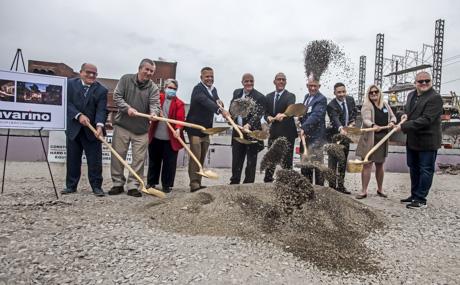
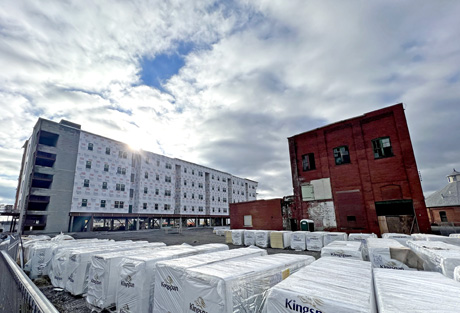
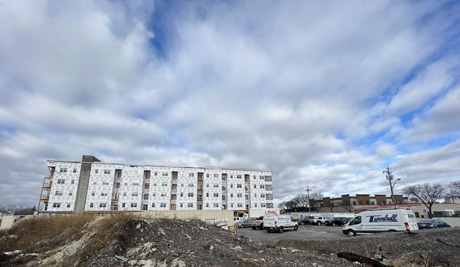
Top Photo of the current Ellicott Station project in Batavia, by Howard Owens; and file photo of the groundbreaking by Howard Owens. Bottom two photos also from today of construction by Howard Owens.
Gov. Hochul announces applications for homeowners assistance fund of $539 million
Press Release:
Governor Kathy Hochul today announced that applications are now being accepted for the New York State Homeowner Assistance Fund (NYS HAF), a program that will provide up to $539 million in aid or other direct assistance to help eligible homeowners who are at risk of default, foreclosure, or displacement due to financial hardship caused by the pandemic. New York was the first state in the nation to receive U.S. Department of the Treasury approval to launch its program.
"For many, buying a home is the greatest source of economic and social stability, and our Homeowner Assistance Fund - the first in the nation to be approved - is a critical tool to help ease the pain of the pandemic felt disproportionately in rural communities, communities of color, and immigrant communities," Governor Hochul said."My administration will continue to stand by homeowners, renters and all New Yorkers every step of the way as part of our economic recovery."
New York State Homes and Community Renewal Commissioner RuthAnne Visnauskas said, "What we do now to help our fellow New Yorkers keep their homes will impact communities and our state for generations to come by contributing to its vitality and building future successes. We cannot and we will not stand by as homeownership and economic gains are threatened in historically disadvantaged communities. Working with our partners in legal services and community-based housing organizations, we have designed the Homeowner Assistance Fund program to help our at-risk families in every corner of the state regain financial stability."
Attorney General Letitia James said, "As the COVID-19 pandemic continues to wreak havoc on the health and wallets of New Yorkers, it is critical that homeowners are granted the relief they need," said Attorney General Letitia James. "The Homeowner Assistance Fund will go a long way in helping homeowners get through this crisis, but it's imperative that these funds are used to support not replace the mortgage industry's own efforts to help struggling homeowners. Through our new Mortgage Enforcement Unit, my office will ensure that these funds go where they are needed and can protect as many homeowners as possible."
Designed and administered by New York State Homes and Community Renewal (HCR), NYS HAF targets low- to moderate-income homeowners who are behind on mortgage payments, property taxes, and water and sewer bills. The program is also open to owners of cooperative or condo units who are behind on maintenance fees, and manufactured homeowners behind on chattel loans, retail installment contracts or lot rents.
Applicants may receive financial assistance to catch up on missed housing payments, to reduce mortgage debt to make monthly mortgage payments more affordable, and for homeowners who are unemployed, assistance with up to six months of future housing payments.
HCR is also working in partnership with the Office of the New York State Attorney General's Mortgage Enforcement Unit to advocate with mortgage lenders and mortgage servicers to ensure homeowners are receiving all available relief under federal and state rules. This may include extended mortgage terms, deferment of missed payments or forbearance amounts, and lower interest rates to reduce monthly payments.
The NYS HAF call center - 844-77-NYHAF (844-776-9423) - will operate Monday through Saturday from 7 a.m. until 8 p.m. to assist homeowners and provide critical information about the program and instructions on how to apply.
The NYS HAF website - www.nyhomeownerfund.org - includes Frequently Asked Questions, a step-by-step application guide, and a document checklist so that applicants know what documentation may be needed to submit their application.
Last month, Governor Hochul announced the launch of the NYS HAF program website, an information call center, and a multilingual marketing campaign that is helping educate homeowners about the program and ensure all eligible New Yorkers, especially those in non-English speaking households, are ready and able to apply.
By examining previous assistance state programs, HCR designed a more streamlined application to ensure the process is simple and easy for homeowners to navigate. Efficiencies include:
· Utilizing several industry-standard, third-party verification technologies that confirm applicant identification and/or ownership, and may limit the number of documents that a homeowner needs to provide as part of their application.
· Allowing the application to be started, paused, and resumed later without losing data and information already entered.
· Accepting signed attestations from applicants to minimize the number of documents they will need to submit.
To make the application process accessible for all homeowners, and to assist those with limited access to technology or limited English language fluency, HCR has made the following accommodations:
· Applicants may authorize a relative or other surrogate to submit an application on their behalf and continue to communicate directly with program staff to track the status of that application.
· NYS HAF has partnered with a network of over 70 housing counseling and legal services providers to allow direct access to the online application portal and who will be able to submit multiple applications on behalf of their clients.
· Homeowners can contact the NYS HAF call center and apply over the phone.
· The website and supporting materials are available in English and ten additional languages: Arabic, Bengali, Haitian-Creole, Italian, Korean, Mandarin, Polish, Russian, Yiddish, and Spanish.
· The online application is available in English, Arabic, Bengali, Haitian-Creole, Italian, Korean, Mandarin, Polish, Russian, Hebrew, and Spanish.
· The Call Center will be able to assist with language translations for any application
Since announcing the program in early December, HCR mobilized an outreach and education campaign directed to vulnerable homeowners to ensure they understood the program and were prepared to apply. This included mobilizing a team of 23 community-based organizations, covering every region of the state, to work with their targeted constituencies of at-risk homeowners. Areas of particular interest are those historically subjected to housing discrimination, areas where homeowners may have limited access to the internet, and communities where there is a high level of homeownership distress.
In addition, a statewide multilingual marketing campaign was created in an effort to reach vulnerable homeowners in their own language through trusted media outlets in communities where English is not the primary language.
The NYS HAF program is administered by Sustainable Neighborhoods LLC, a non-profit community development financial institution selected through a competitive Request for Proposals. Sustainable Neighborhoods has extensive experience administering foreclosure prevention and loss mitigation programs across the state.
Sustainable Neighborhoods CEO/Executive Director Christie Peale said, "Thousands of low-income homeowners who have been struggling financially because of COVID will now get the relief they desperately need, thanks to the New York State Homeowner Assistance Fund. Whether you live in a manufactured home, a condominium, coop or a single-family home, we encourage you to apply as soon as possible to receive assistance. It is urgent that we help as many families as possible keep their homes, despite the damaging impacts of the pandemic. We thank Governor Hochul for her leadership and dedication."
Hawley and colleagues call on Cuomo to release $1.3B in federal CARES Act housing funds
Press release:
Assemblyman Steve Hawley joined other members of the Assembly and Senate Minority Conferences on Wednesday in calling on Gov. Cuomo to release $1.3 billion in CARES Act housing assistance funding to aid tenants and landlords.
If the money were to go unused by the end of September, it is possible the federal government could take the funds back, leaving tenants and landlords without much-needed assistance. Tenants have struggled to pay rent due to the pandemic, causing many small landlords to face difficulty in paying their mortgages.
“People need this money now more than ever, and to leave it sitting around during this time of great need is unconscionable,” Hawley said. “Helping every day New Yorkers should be our number-one priority during these times, and for most people their priority number one is keeping a roof over their heads.
"This money will go a long way toward keeping people’s rents and mortgages paid, and I see no reason we should wait any longer in getting it to those who need it most.”
Tribal communities to get $3.7M in HUD grants to improve housing
Press release:
U.S. Senator Charles E. Schumer and U.S. Senator Kirsten Gillibrand today announced $3,702,246 in federal block grants for seven New York tribal communities through the U.S. Department of Housing and Urban Development’s (HUD) Indian Housing Block Grants Program.
Included is $35,007 for the Tonawanda Band of Seneca in Basom.
The funding, authorized in the American Rescue Plan, will go toward developing new affordable housing projects and improving existing units on Indian reservations and lands, in turn providing tangible relief to individuals and families.
“Let me make this clear: safe housing, especially during a pandemic is a right,” Senator Schumer said. “This federal investment gets us closer to our goal of ensuring that every New Yorker has a safe place to call home, including our neighbors in New York’s tribal communities.
"I have long believed in the importance of directing resources to historically disadvantaged communities, and that need is even more pronounced in this crisis which has done so much to worsen those inequities. I will always fight tooth and nail so all of New York’s tribal community members have a place to call home.”
“I am proud to announce this American Rescue Plan funding to combat homelessness across the country,” Senator Gillibrand said. “The COVID-19 pandemic and resulting economic crisis have exacerbated housing insecurity across New York, especially in underserved communities.
"This funding will help ensure that New York’s tribal communities have access to stable, safe, and affordable housing. No one should ever have to question whether they’ll have a safe place to sleep at night during the pandemic and beyond.”
TRIBE
CITY
AMOUNT RECEIVED
Cayuga Nation
Seneca Falls
$186,448
Oneida Indian Nation of New York
Verona
$512,804
Seneca Nation of New York
Irving
$1,745,554
Shinnecock Indian Nation
Southampton
$67,575
St. Regis Mohawk Tribe
Akwesasne
$1,119,851
Tonawanda Band of Seneca
Basom
$35,007
Tuscarora Nation
Lewiston
$35,007
Former GCC student and UMMC employee hired as Housing Specialist at ILGR

Submitted photo and press release:
Independent Living of the Genesee Region (ILGR) welcomes Kahlil Simon into his new position as a Housing Specialist.
In this role, he will assist individuals to apply for, and navigate, the programs and services offered through ILGR, including, coordinating housing evaluations for persons experiencing homelessness or at risk of homelessness, household budget counseling, employment advocacy, home environmental accessibility consultation, as well as serving as a liaison with landlords.
Prior to this promotion, Kahlil Simon served ILGR as a Home and Community-Based Services (HCBS) Peer Specialist, where he earned a New York Peer Specialist Provisional Certification.
Before his coming to the Agency, he had worked as an Imaging Services Secretary at United Memorial Medical Center in Batavia, where he was recognized with an Exemplary Service Award. During his tenure at the Medical Center, Simon was inspired to seek work that was more community service-oriented, ultimately obtaining employment with ILGR.
About his new position, he says, “Here at ILGR, it’s my goal to provide a service to the members of our communities that are in need of assistance, while upholding the high standards of this organization.”
Simon attended Genesee Community College in Batavia after moving to the area from Brooklyn.
ILGR is delighted that Kahlil Simon will continue to serve the disability community in this new position.
Independent Living of the Genesee Region is a member of the Western New York Independent Living Inc. family of agencies that offers an expanding array of services to aid individuals with disabilities to take control of their own lives.
Hawley announces $6.3 million funding for senior housing in Le Roy
Press release:
Assemblyman Steve Hawley (R,C,I-Batavia) today proudly announced that more than $9 million has been awarded to improve the availability of two affordable housing projects and revitalize the surrounding community.
Frances Apartments II in the Town of Sweden was awarded $3.4 million to create 48 affordable apartments, and $6.3 million was awarded for La Rosa Villas in the Village of Le Roy, creating 60 affordable apartments for seniors close to the village's main street and transportation.
“Home ownership is ingrained as part of the American dream, and helping our seniors and most vulnerable New Yorkers achieve safe, affordable and comfortable living situations is a primary responsibility we all realize as lawmakers,” Hawley said.
“I am proud to see such a large investment injected into the communities of Le Roy and Sweden, as these investments will lift up all residents, but especially those seeking affordable housing. I am pleased to take part in such an important announcement and look forward to these developments serving residents for years to come.”
The funds were made available through New York State Homes & Community Renewal's 2018 Unified Funding Application, a streamlined process to apply for Low-Income Housing Tax Credits and low-interest loans for affordable, multifamily developments.
Housing needs assessment for Genesee County finds areas of oversupply, but also great demand
Genesee County has an oversupply of owner-occupied housing for the extremely low-income people and not enough for market-rate renters, according to a housing study released yesterday.
There's also a shortage -- to the point of being essentially nonexistent -- of single-family, owner-occupied housing for households with incomes of $100,000 to $150,000.
Ed Flynn, a consultant with LaBella Associates, and 24-year resident of Batavia, presented the findings of the county-commissioned housing needs assessment to a gathering of local officials and residents last night at the Old Courthouse.
Other problems facing the county are a slowly declining population and an aging population.
"The demographics and the economics are changing," Flynn said. "The community must recognize that the type of community that Batavia or Genesee County was 10 years ago has completely changed. The type of households have completely changed and we have to recognize and acknowledge that economic development does matter. So in order to avoid the current projections where there is continual population decline you really need to create jobs."
The flip side to shortages in housing is there is demand.
There is demand for middle-income, owner-occupied, single-family housing. There is demand for smaller-unit, smaller-lot, single-family housing in the city. There is demand for market-rate rental properties.
And what people say they want in their housing of the future is housing that is ADA-accessible, with sidewalks and trails and access to alternate forms of transportation and connected to amenities and services.
"Based on the survey, we got a lot of feedback," Flynn said. "People said, 'we want more than just a house. We want a community.'
"So let's look at some small lots, areas of compact development patterns where you can walk and where there are landscaping and smaller houses. Let's look at some downtown areas or some compact development where you can do some of these high-end houses or a mixed-income housing in the downtown areas or some strategic areas in other villages and towns."
As evidence of the demand for market-rate rentals, Flynn pointed to the new apartments that have been added to the downtown housing stock over the past few years. In each case, these apartments were snapped up immediately at rates of $1,000 to $1,500 a month.
Flynn said it will be interesting to see if that trend continues with the four new apartments in the former Newberry's building go on the market, but based on the survey data, it appears the demand for that kind of housing is still present in the City of Batavia.
According to the data gathered for the report, there are 2,070 households in the county with upper-level incomes and only 889 rental units suitable to that market.
There may be additional opportunities to rehabilitate other existing structures and housing units that meet market demands but with more than 80 percent of the housing in the county more than 50 years old, there is growing demand for new housing.
The problem in attracting new housing development, however, is the low cost of current housing.
The median single-family housing price has dropped from $115,192 in 2000 to $107,000 in 2015. Rental rates have risen only slightly, from $715 in 2000 to $724 in 2015.
The average cost of an existing housing unit is $83 per square foot. The average cost of new construction is $175 per square foot. That means an existing 1,650-square-foot house might sell for $136,950 but it would cost $288,750 (excluding developer profit and permitting fees) to build a new 1,650-square-foot house.
Without government-backed incentives, Flynn said, it will be difficult to attract developers to Genesee County to build new housing.
Those trends holding housing prices down also means owners are less likely to upgrade and improve their existing properties, whether owner-occupied or rental.
"If you have a house and you know the value is not going to change, you are probably not going to do as many updates," Flynn said.
Among the recommendations in the report is creating a countywide program to provide incentives for owners of single-family homes to rehabilitate and upgrade those units.
Over the next 20 years, there will be a demand for 4,804 additional housing units in Genesee County, according to the report.
There will be a need for 2,858 single-family units, with 1,699 on standard lots and 1,159 on small lots.
Nearly 80 percent of the 4,804 new units will need to be rental properties, with 1,138 of those being part of multi-family complexes.
While most people, the survey found, want to live in single-family homes -- 78 percent -- there increasing interest in multi-family or small units, such as patio homes, townhouses, senior living apartments, duplexes, and apartments (89 percent).
Forty-two of the respondents said they want to move into smaller living units and 33 percent said they want lower cost housing in the future.
There is also a strong need for housing the meets the needs of people with disabilities, with 13.4 percent of the population having some sort of disability. With an aging population, that number will grow. Nearly 20 percent of the people in poverty are disabled.
For the poor, housing is often substandard or too expensive for their income levels. More than 6,800 households in the county are living with housing with problems. Examples include plumbing problems or substandard kitchen facilities. More than 20 percent of renters are paying more than one third of their income in rent and more than 20 percent are paying more than 50 percent of their income in rent.
For owner-occupied homes, there is an oversupply of extreme/very low-income units, with only 885 households qualifying at that income level and 3,355 such units in the county.
Meanwhile, there are 15,050 households who could afford market-rate and higher owner-occupied properties but only 8,871 such units exist.
There is also demand in the low-income range -- between extremely low income and middle income -- for suitable housing.
For renters at the very low-income spectrum, there are 1,600 such households and only 565 such units available.
Meanwhile, there is an oversupply of low-income and middle-income rental units.
"We need to consider economic development," Flynn said. "And I'm not just saying that because I like the folks at the EDC (county Economic Development Center) or other economic professionals, because if you create jobs and you create wealth you're going to create demand for housing."
Click here (PDF) for the written report.
Results revealed Wednesday night at Old Courthouse for GC housing needs and market analysis
The results are in for the 2017 Genesee County Comprehensive Housing Needs Assessment and Market Analysis. LaBella Associates will be sharing these results with the public at 6 p.m. on Wednesday, Feb. 7, at the Old Courthouse, Third Floor, 7 Main St., Batavia.
No reservations necessary.
Attendance may qualify for 1 hour of training credit for planning and zoning board members.
Questions may be directed to Felipe A. Oltramari, director, GC Department of Planning, 815-7901, Felipe.Oltramari@co.genesee.ny.us
Batavia Housing Authority receives $227K grant in latest round of federal funding
The Batavia Housing Authority will receive a $227,424 federal grant as part of a $397 million package for New York's public housing programs.
The authority provides subsidized housing to low-income residents in four complexes in Batavia, including 400 Towers, The Pines at 4 MacArthur Drive, Edward Court at 15 Edward St., and The Terraces at 193 S. Main St.
Press release:
U.S. Senators Charles E. Schumer and Kristen Gillibrand today announced $397,628,820 for housing authorities across New York State. The funds were allocated through the U.S. Department of Housing and Urban Development’s (HUD) Public Housing Capital Fund. Schumer and Gillibrand said the funding will help housing authorities develop, finance and modernize their public housing facilities.
“Having a roof over your head is one of life’s basic necessities, so we must do everything we can to help provide those truly in need with a decent and affordable place to live. This federal funding will help support affordable housing initiatives throughout New York that assist needy families, the elderly, and persons with disabilities to find an affordable place to live,” Senator Schumer said.
“We need to invest more federal funds to help more low-income families, the elderly, and persons with disabilities in New York with access to affordable and safe housing,” Senator Gillibrand said. “These resources are vital for vulnerable communities and I will continue to do everything I can in the Senate to make sure that all New Yorkers have the opportunity to reach their full potential.”
HUD’s Office of Capital Improvement administers the Capital Fund program, which provides financial assistance in the form of grants to public housing agencies (PHAs) to carry out capital and management activities; acting as the primary tool to preserve New York's affordable housing stock. These federal dollars are used to increase a PHA's ability to maintain the physical infrastructure of developments and improve the safety and security of its residents.
Survey seeks your opinion on county's housing needs
Press release:
Genesee County wants to know your thoughts on housing and if local housing meets your needs. A survey has been launched to get input from County residents and is available online at:https://www.surveymonkey.com/r/geneseehousing
Paper copies will be available next week at the Richmond Memorial Library and the Genesee County Senior Center. The survey will help the County, its municipalities, housing developers and other housing providers identify unmet needs and demand for various types of housing throughout the County.
The survey is part of the Genesee County Housing Needs Assessment and Market Analysis project. It will document housing needs, analyze the housing market and identify feasible strategies to meet the future housing needs of Genesee County. Genesee County, its municipalities and local housing agencies can use the report's findings to support both rehabilitation and new construction of housing.
Whether you are happy with where you live now or are looking at new housing options for the future, please take a few minutes to fill out the survey. The survey will be launched June 19th and responses will be accepted until July 7th.
Housing Needs Assessment will give planners the tools they need to make good decisions about projects
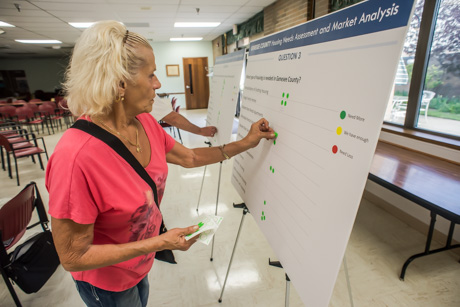
It takes good data to make good decisions and a lot of times when planners are considering housing projects, the developers with the proposals are the ones who have all the data.
A new housing needs assessment for Genesee County will help solve that problem, said Felipe Oltramari, the county's planning director.
"(Developers) are not going to come into a market where they know there is no need," Oltramari said. "They did their own study, but it's a private study that is focused on their segment of the market."
As part of the needs assessment process, the county hosted an open house at the Senior Center on Bank Street last night, which gave the residents who attended an opportunity to provide feedback on what they see as local housing issues, whether it's too much stock in one place, or of one type, or not enough of something.
Oltramari said the comprehensive study will also use interviews with various stakeholders in the community, whether they be veterans' groups, groups that serve seniors, the disabled and business groups. Officials and consultants will also try to identify the housing needs of Millennials. The goal is to get a broad picture of what is needed, which will help guide planning decisions and maybe uncover undetected needs.
"When a study like this happens, you will be able to put that information out there for some developers who may not be looking at this area," Oltramari said
The study is expected to be completed by December.
Oftentimes developers look at census, sales data and current housing patterns to identify a need in a community -- that same data will be gathered for the county's assessment -- and then try to fit a project into that community. But in a small community such as Genesee County, there are potentially niche needs that private developers won't uncover on their own. The county's housing needs study could identify a potential need and make that information available to developers who might decide trying to fill that need could be profitable.
"We want to make sure we’re looking at all segments of the market," Oltramari said. "One thing we heard, especially when Muller Quaker came, there was no housing for executives and lot of them ended up living outside of the county. When STAMP comes, we want to make sure the same thing doesn't happen."
The county's own study will also be used to confirm, or not, what private developers say is a local need. For example, when DePaul Properties was still pursuing a $25 million project on East Main Street in the City, CEO Mark Fuller said DePaul had identified needs in the city for more housing for disabled people, seniors with diminished mobility and veterans. Asked where those people are now, Fuller said they are most likely living with parents or in substandard housing.
That could be an example of a market need that isn't readily apparent to most observers, but solid data could help identify.
(The project was stymied by a City Council decision not to change the zoning of the property from industrial to commercial.)
"They (developers, such as DePaul) know that and they might do their own research and come to that conclusion, but we haven’t seen that research," Oltramari said. "I’m sure there is probably that need, because they have a business model and they have to make sure the project is going to work, so there is some evidence, you have to trust that. But it’s nice to really have the tool to show 'yes, there is that need and this is something we should support as a community.' "
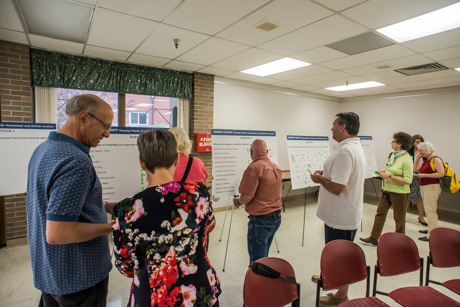
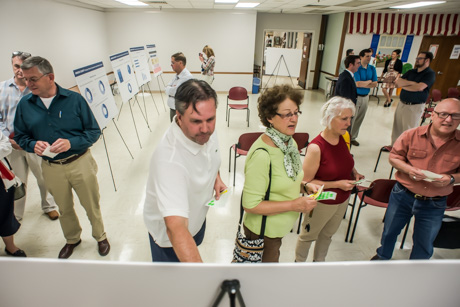

Developer of new DePaul project may ask council to table tonight's vote on rezoning
The developer of an apartment complex intended to provide an increase in affordable housing for people with disabilities, especially seniors with disabilities, in Batavia, said this afternoon that he intends to ask the City Council to table a resolution tonight that would rezone the land needed for the apartments.
Mark Fuller, a Genesee County resident, intends to build more than 80 units in a complex at 661, 665 and 679 E. Main St., Batavia.
"We're actually going to ask them to table the vote tonight until a housing study comes out in the middle of the year that I think very much supports the need for this type of housing," Fuller said. "That (the study) was brought up by a couple of council members, so we at least want to give them a chance to read the study before taking the vote."
The lots are currently zoned industrial and in order for the project to go forward, the council would need to rezone it to C2, a commercial designation that would allow apartments.
The lots are a former state police barracks and are surrounded by mostly residential and commercial property.
Two weeks ago, the council voted by a narrow 5-4 margin to move the resolution for rezoning to tonight's business meeting.
"In all the projects that we've done, we've had nothing but great support," Fuller said. "I'm just surprised there's been some pushback from City Council."
Fuller is currently working on 18 similar projects around the region for DePaul Properties, he said.
He said he thinks there is community support for building the apartments and that there is an unmet need in the community for this type of affordable housing oriented toward people with disabilities, seniors with disabilities, and veterans.
"We've had nothing but terrific support from everyone I've talk to about this," Fuller said.
He said once completed, even with a PILOT agreement in place, property taxes generated by these apartments would still be four times more revenue for the city and school district than the revenue currently generated by the existing use. Plus, the development would pay a substantial bill for municipal sewer and water.
The City Council meets at 7 p.m.
Interview conducted by The Batavian's news partner, WBTA.



